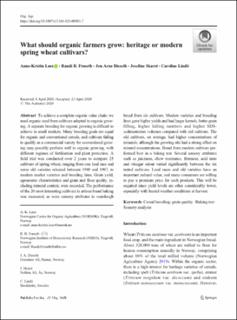| dc.description.abstract | To achieve a complete organic value chain, we need organic seed from cultivars adapted to organic growing. A separate breeding for organic growing is difficult to achieve in small markets. Many breeding goals are equal for organic and conventional cereals, and cultivars failing to qualify as a commercial variety for conventional growing may possibly perform well in organic growing, with different regimes of fertilisation and plant protection. A field trial was conducted over 2 years to compare 25 cultivars of spring wheat, ranging from one land race and some old varieties released between 1940 and 1967, to modern market varieties and breeding lines. Grain yield, agronomic characteristics and grain and flour quality, including mineral content, were recorded. The performance of the 20 most interesting cultivars in artisan bread baking was measured, as were sensory attributes in sourdough bread from six cultivars. Modern varieties and breeding lines gave higher yields and had larger kernels, better grain filling, higher falling numbers and higher SDS-sedimentation volumes compared with old cultivars. The old cultivars, on average, had higher concentrations of minerals, although the growing site had a strong effect on mineral concentrations. Bread from modern cultivars performed best in a baking test. Several sensory attributes such as juiciness, chew resistance, firmness, acid taste and vinegar odour varied significantly between the six tested cultivars. Land races and old varieties have an important cultural value, and many consumers are willing to pay a premium price for such products. This will be required since yield levels are often considerably lower, especially with humid weather conditions at harvest. | en_US |

